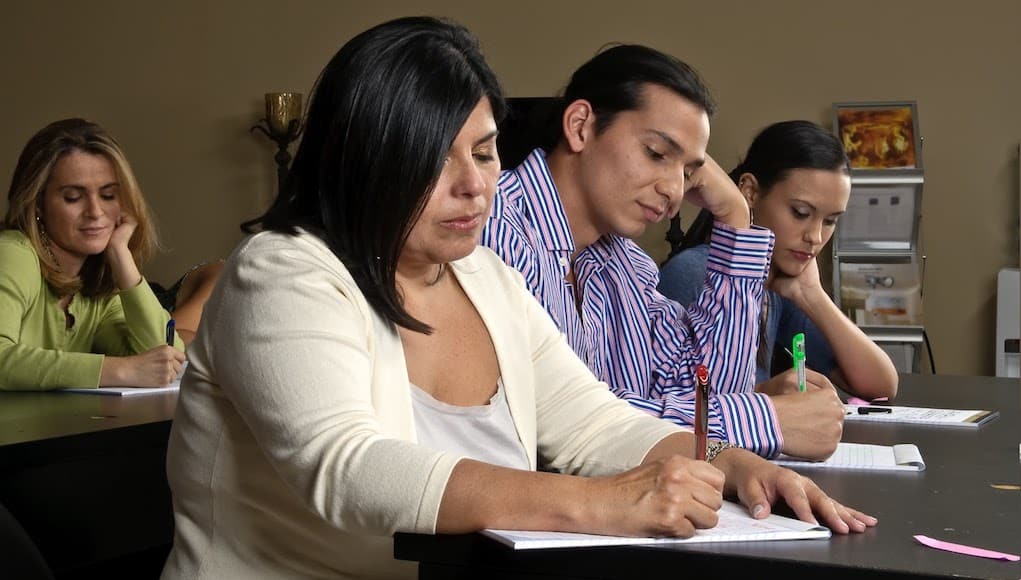Using Technology and Motivation to Reach Adult Learners

By Mary Murphy
As any good educator knows, we humans never stop learning. It’s a lesson we try to impart to students starting in kindergarten right through graduation using concepts such as growth mindset, which places time and persistence above natural ability. At my district, Sweetwater Union High School District in California, we’ve successfully put this theory to the test by building a thriving adult education program that has grown to become one of the largest in the state.
Teaching adults is not exactly like teaching younger students. Adult learners don’t have to come to class every day, and they often can’t give nearly as much of their time. But they’re driven by a want or a need to learn new skills and improve their knowledge. Our job is to match their drive and make their experience engaging and meaningful given these constraints.
As of this year, Sweetwater serves about 25,000 adult learners spread out among four district schools and 20 off-site locations (one of them at a Tyson Chicken plant, set up to be more convenient for employees). Some of our adult-ed students take their courses virtually, with students checking in with teachers via Skype or by email, but a majority spend at least some time in a classroom.
Variety is the spice of adult learning
The key to success for any adult-ed program is variety. We offer our students courses in everything from beginning literacy up through high school diplomas, GEDs and technical and vocational ed classes. Our students study culinary arts to become pastry chefs, get hands-on with welding and business trades, and earn valuable workplace certifications such as Cisco A+.
However, a solid majority of our students come to us for help improving their English-language skills. I oversee the ESL program at Sweetwater’s Division of Adult Education, where we invest a lot of our resources. Even in our career and technical education courses, we’re working on building a bridge with our ESL instructors so that they can be on hand to offer students the ELL support they need to thrive in any of our courses. When instructors collaborate, we’ve seen amazing things happen, such as receiving extra assistance from their ESL teacher to build the vocabulary they need for their technical courses.
Adult Learner Connectivity: Smartphones
Because we serve a relatively low socioeconomic area populated by many recent immigrants, not all of our students have reliable access to the internet or computers outside class time. More and more though, we’ve seen our students—like adults everywhere—come to rely on their smartphones for everything, including internet access, and our program was quick to turn that into an advantage.
Many of the software programs we use with students, such as Learning Upgrade which provides skill reinforcement and practice for our English language learners, feature mobile apps. This means students can download the app and work on assignments whenever it suits them. Our learners have work schedules and shifts that span all hours, so if a student is on the bus at 5 a.m. and has some time to study, we’re all too happy to give them a platform to do so.

Our teachers use these apps in various ways. Some use them on traditional computers as an activity to start off each class, some as a way to reinforce class concepts, and others purely as another option for practice. Since internet use can be spotty among our students, we never make online learning a requirement, but for those students who do use the apps, it can provide a great learning experience in a short amount of time—sometimes in as little as 10 minutes. And we use it as an encouragement tool. Since we pay for the apps per license, students know that their use of an app is being tracked and that if they don’t use it, we can (and do) take it away.
Engagement Essential for Success
Because work schedules and childcare can be unpredictable for our students, our instructors need to be incredibly adaptable, as attendance in their classes can vary from one week to the next. We’re a low-cost education option for our students, and unlike our K-12 counterparts there’s nothing legally keeping students in class. If a learner feels disengaged from the material or doesn’t like the class, they simply stop coming. Fortunately, we typically have a core group of students (maybe half the class) who can come about 80 percent of the time and can provide additional structures for the other students who might attend.
Many of our students are parents themselves, making for some very interesting interactions at home. Kids watch their parents working on their Learning Upgrade, Burlington English or Rosetta Stone assignments with some degree of curiosity, and want to help out. Studying in many of these homes thus becomes a family activity. Kids also learn a valuable lesson on the importance of studying as it’s modeled for them by their parents.
While our program still faces some challenges around engaging our students and keeping them enrolled in programs long enough to complete their goals, technology has allowed us to make some remarkable strides. Since some of our funding comes from a federal grant, we administer assessments called CASAS tests to track student progress. Among our ELL population, we’ve noticed some significant gains, especially since we’ve implemented the mobile app.
These gains, combined with our motivating teachers—who make special efforts to highlight good work and celebrate accomplishments—are helping our adult learners realize something we’re also trying to teach their children: with a little effort and a bit of persistence, learning is truly limitless.
For more, see:
- 10 Reasons why Lifelong Learning is the Only Option
- The Bar Has Been Raised and the Rules Have Changed
- Infographic | The Future of Lifelong Learning
Mary Murphy oversees the ESL program for Sweetwater Union High School District’s Division of Adult Education. Follow them on Twitter: @SUHSD
Stay in-the-know with all things EdTech and innovations in learning by signing up to receive the weekly Smart Update.






0 Comments
Leave a Comment
Your email address will not be published. All fields are required.